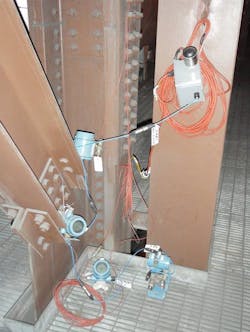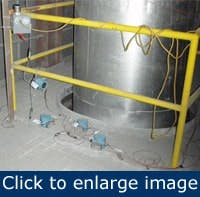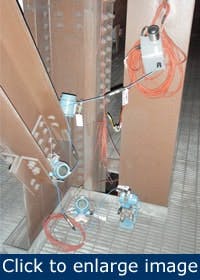Real-time data acquisition with WirelessHART technology
Progress Energy, a publicly owned electric utility serving North Carolina, South Carolina and Florida, has a sort of internal SWAT team to stamp out inefficiency. That team, called the Performance Testing Group, consists of four engineers and technicians led by Dick Fletcher, the team manager. It keeps plant equipment and systems running smoothly by traveling from plant to plant and testing, troubleshooting, and verifying performance standards on new and upgraded equipment.
The team members, sometimes in groups of two, service the utility’s 32 locations. Together, the plant’s capacity is more than 22,000 MW, and it serves 3.1 million consumers across Florida and the Carolinas. Testing supplements each plant’s individual efforts to ensure peak efficiency and output.
Field testing requires portable data acquisition systems that collect data from multiple process instruments located throughout a facility. Typically, the test records time-stamped data through a gateway and into a laptop-based spreadsheet-type application. Additionally, test equipment must be portable and flexible enough to operate with a constantly changing number of instruments and scan rates.
The problem with hard wires
The group maintains 240 transmitters, mainly for temperature and pressure, and some flow devices. These have traditionally been hardwired to HART multiplexers to accommodate cable runs across facilities, even over streets, to conduct tests. Setting up a test run occupied significant time and labor.
Conducting a test entails more than the test itself. Any test could entail days for setup and another for teardown. Hardwired network multiplexers were well-worn and, in some cases, failing because of wear and tear. Likewise, the profusion of wiring risked damage as cables were used and reused from one site to the next connecting at times more than 100 far-flung sensing and transmitting instruments across a facility and crossing not just the plant, but also roadways.
With the introduction of the WirelessHART protocol and the commercial availability of network WirelessHART adapters that conform to the standard, the group sought to replace its aging test equipment and streamline testing with a new wireless system. Fletcher explains that the traveling test engineers had a major investment in existing HART Smart Transmitters. “The logical thing to do was get a common data acquisition system to be shared across the system by Performance Testing,” he says.
He set short-term goals for a new system that could handle a variety of instruments, with special emphasis on high-accuracy pressure and temperature transmitters. The system also had to be easy to configure, because every plant requires its own configuration. And, of course, the system would have to interface with standard commercial instruments using standard protocols.
Fletcher also set longer-term goals for a new, wireless system as a way to broaden the scope of testing and as a means of achieving a remote data flow over the corporate wide-area network (WAN) for remote testing and analysis. But first, the group had to establish a system to serve as the proof of concept.
Project objectives
Test setup was arduous before commercial products, particularly network adapters that bring HART transmitter data, had implemented the WirelessHART specification. One such adapter, the MACTek Bullet, provided Fletcher’s group with the ability to connect eight existing HART-enabled devices operating in an all-digital multidrop network mode. Knowing this, the Performance Testing Group hoped to achieve five specific objectives:
- Develop a common field data acquisition system the testing group can use across the company
- Allow equipment sharing across the system and minimize the total company inventory
- Take advantage of HART’s ability to collect data digitally and in multidrop mode
- Ease the installation of the test equipment to minimize time and effort
- Benefit from a flexible, easily expandable and easily configurable system.
These objectives exceeded Fletcher’s initial expectations. The project focus in the early, research phase was mainly upon wired multiplexer-based systems, because “the wireless equipment that we were initially aware of was expected to be out of our financial reach,” says Fletcher.
Implementing wirelessly
“Like everyone else in these economically challenging times, we had to get the best bang for the buck,” says Fletcher, “and that meant that we had to maintain compatibility with our existing investment in HART-enabled transmitters. When we were planning our purchase, we learned that MACTek had working prototypes of the Bullet.”
The prototype Bullet, introduced in 2009, could support six HART transmitters in field-proven HART multidrop mode. It has since expanded to eight, which is what the Performance Testing Group now uses. For either iteration, Fletcher explains this capability meant a wireless gateway could replace the failing multiplexers, and far fewer cables would need to be deployed for temporary test transmitter installations. “The economics of a hybrid wireless-wired HART system became more feasible for us to consider,” he says.
The Performance Testing Group’s wireless solution uses pre-existing Rosemount Smart HART transmitters and some key pieces of new equipment:
- MACTek Bullets
- MACTek HART modems
- Siemens Simatic PDM software
- Emerson Smart Wireless gateways
- 24 VDC power supplies from Acopian
- Electrical enclosures from Lowe’s Hardware
- Mody transmitter cables — three-conductor with Neutrik 3-pin XLR connectors and five-conductor RTD cables with Neutrik 5-pin XLR connectors.
The resulting system uses the Bullets to communicate HART data, including the process variables, through the Emerson gateway, into a laptop PC, where data are imported to an Excel spreadsheet using Matricon Analytics’ plug-in Excel Reporter, an OPC plug-in.
MACTek’s Bullet is designed to provide access to real-time information from installed intelligent HART-enabled field devices. It is available in general purpose as well as in certified intrinsic safety and explosion-proof models. The Bullet recognizes each HART-compliant device and sends that information back, with the instrument’s tag name, so the team’s data acquisition can import field data.
Before its first use, the Bullet and WirelessHART protocol were subject to an IT security review in compliance with North American Electric Reliability Council — Critical Infrastructure Protection (NERC-CIP) requirements and passed with flying colors. “While we were able to show no connection to the plant’s cyber assets, they were impressed with the security of the encrypted HART protocol,” says Fletcher, who has one caveat to using the wireless network adapters. Because WirelessHART technology uses the same 2.4-GHz frequency band as Wi-Fi, users should be aware of the range limits and possibility of interference between objects and antennas.
However, in actual use, it turned out that the Bullets don’t necessarily need be in line-of-sight to establish a network. He also notes that a WirelessHART network can take 10 or 20 minutes to get fully established with all HART subdevices reporting, “but the radio links will form in circumstances that Wi-Fi couldn’t hope to achieve, and they just work,” says Fletcher. “Wi-Fi was designed for speed, while WirelessHART was designed for data reliability.”
Benefits
The advantages of the new system were apparent, from up-front cost to the long-term reliability of the Performance Testing Group’s data acquisition system and, in turn, the reliability of assets across Progress Energy’s 32 plants.
The Bullet played an important role in the project’s success. Whereas some technologies investigated initially were outside the group’s financial reach, MACTek’s Bullet provided cost savings from the start.
One leading wireless adapter on the market provided the same kind of wireless capability, but each adapter handled only one transmitter at a time. The cost of using such hardware on the 240 transmitters the performance group maintained was quoted at roughly $180,000. Instead, the Bullets were chosen for their ability to handle eight devices each, costing $22,000 at list price — a $158,000 savings. Using the multidrop capability and the Bullet was key to getting this project approved.
Labor savings were evident from the group’s first outing with the new system. This was a large test using 114 instruments connected to 17 MACTek Bullets at Progress Energy’s Crystal River, Florida, generating facility.
[pullquote]“I estimate that we saved 100-150 man-hours,” says Fletcher. “On a small test where we tried the Bullet, we saved about six man-hours on a setup that took about 10 man-hours to set up using the wireless. With an average of 15 tests a year and saving an average 33 hours of labor each, that works out to $20,000 savings per year.”
Fletcher says the multi-vendor test system has been reliable, from the Emerson gateways to the MACTek Bullets. Beyond up-front savings, the new system reduces cabling, as the radio links eliminate situations that placed cables at risk of damage, says Fletcher, adding there also will be savings over time. The test still takes as long as it must, but setup and teardown are much faster, and the group can better focus on its job.
“Along with the streamlined process for data acquisition, we get a better picture in real time of how our test equipment is performing and communicating,” says Fletcher.
How far can you take the Bullet bus?
While HART is a hybrid analog/digital specification, wireless data transmission is all-digital. This allows HART technology to transcend its heritage as a diagnostic tool and enter the world of digital bus functionality.
In wireless multi-drop mode, the analog signal isn’t used; instruments use the 4-20 mA signals for power, but process variables, from tags to diagnostics and process variable measurements, are transmitted digitally. So, in a sense, the technology might open the door for new applications previously thought to be the sole domain of digital fieldbus networks, such as condition monitoring and asset management. A MACTek Bullet transmiting data on eight multi-dropped instruments to higher levels once every 8 sec (1 sec/device) makes real-time data acquisition a possibility.
Fletcher notes the protocol is built for redundancy and reliability. For his testing purposes, he sets up the MACTek to poll Bullet transmitters every 16 seconds and for his gateways to poll at 20-second intervals.
Future potential
The Performance Testing Group continues to live and learn with its new wireless system. For example, Fletcher might switch some Bullets over to battery power for added flexibility in short-term equipment deployments.
The system’s productivity gains are leading Fletcher to consider expanding the scope of testing from thermal performance to additional tests and diagnostic capabilities. “For instance, we’re currently looking at adapting our dye dilution flow testing to the new system,” says Fletcher. Now that the team can work more quickly, there’s more time for more comprehensive testing applications.
With the test system serving as a wireless proof-of-concept, Fletcher’s group is in discussions with plant personnel to consider permanently installed Bullets in key locations. This can yield benefits at the plant level and beyond, if remote access is granted.
“The Web interface built into the wireless gateways gives us good diagnostics and data on the Bullet radios and the HART devices they support,” says Fletcher. “Further gains stand to be realized if we can get the gateways linked to the corporate wide-area network).” The basic principle is to connect the gateways to the corporate WAN instead of a laptop. Engineers could then evaluate data being collected at any plant without traveling to it. Alternately, the WAN approach also could allow the group or others in the company to make additional or more in-depth evaluation at any time.


